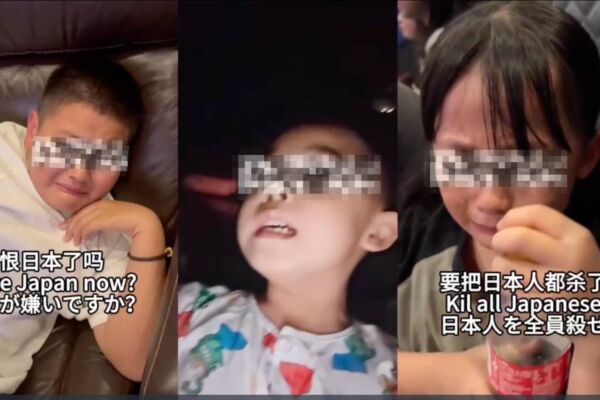The Chinese Communist Party’s so-called “patriotic film,” “The Nanjing Photo Studio,” is being promoted overseas under official backing. The film has sparked controversy due to its incitement of hate and abundance of violent scenes. Some Hong Kong media have indicated that the film is classified as Category IIB in Hong Kong – unsuitable for children and teenagers, though in reality, it should be closer to the Category III rating, which would prohibit viewers under 18.
Following its release in mainland China, “The Nanjing Photo Studio” quickly gained popularity at the box office with many parents taking their children to watch it under official promotion. Short videos on the platform “Douyin” showed children tearing apart their cherished Japanese manga and cards after watching the film, with some children crying and angrily expressing a desire to kill all Japanese people or violently striking a map of Japan with various tools.
An article by author Li Guanru on “Hong Kong 01” on September 1st raised concerns about the film. While “The Nanjing Photo Studio” itself does not explicitly emphasize hatred towards contemporary Japanese people, the hate speech and actions by children in the film do not distinguish between past and present Japanese individuals. The film’s depiction of violent acts such as the slaughter and burning of Chinese people by Japanese individuals, as well as cruel acts like throwing babies to their deaths, has brought about debates on whether children should be allowed to watch the film.
The article mentioned that “The Nanjing Photo Studio” is set to be screened in Hong Kong, where it is classified as Category IIB due to its numerous violent scenes deemed unsuitable for children and teenagers. However, mainland Chinese cinemas have not restricted children from watching it.
Li Guanru pointed out that under Hong Kong’s film classification system, “The Nanjing Photo Studio” is categorized as “unsuitable for children and teenagers” under Category IIB, rather than the stricter “restricted to persons aged 18 or above” in Category III. He suggested that the film should fall between Category IIB and III.
According to Hong Kong’s film classification system, Category IIB includes content with mild profanity, terror, moderate to strong bloody violence, shocking scenes, depictions of suicide, abuse, and drug use. Category IIB serves as a cautionary rating, allowing children and teenagers to watch. Category III, however, comprises content deemed very disturbing or offensive, including extreme violence, explicit language, shocking scenes, and suicide, thereby barring viewers under 18 from cinemas and renting or buying Category III discs.
Unlike Hong Kong’s film classification system, mainland China follows a censorship model instead of a grading system. However, the official censorship of films by the Chinese Communist Party is often criticized for being based on political agendas.
A Chinese national living in Tokyo for many years, Mr. Liang, previously expressed concerns to Epoch Times that elementary school students in China watching “The Nanjing Photo Studio” is a disaster. He questioned the relationship between the film’s content and incidents like the attack on a Japanese mother and child in Suzhou on July 31, which bears the hidden connotation of the Japanese military Unit 731.
Mr. Liang emphasized that European countries place significant emphasis on age-appropriate historical education. For example, popular films like “Life is Beautiful” are recommended for students in junior high school or above due to their portrayal of concentration camp life, while “Schindler’s List” requires a high school level due to its massacre scenes.
“Directly portraying a certain group or nation as demons to children, who have not yet developed the capacity to digest and understand such information, will only lead to simplistic feelings of hatred, deviating from the original intention of education,” he remarked.
Mr. Liang questioned why China lacks a film classification system, suggesting a potential hidden agenda behind the Communist Party’s approach. During the resistance against Japanese aggression, Catholic priest Lei Zhenyuan, who witnessed Communist violence in China, recounted in his work “Enemies Within” how children were forced to witness the beheading of 13 patriotic youth in the village square.
Father Lei stated that children were repeatedly exposed to violence, becoming desensitized to bloody scenes and even deriving pleasure from the stimulation of such violence.
“The Nine Commentaries on the Communist Party” highlighted the Communist Party’s belief that “all social history is a history of class struggle.” To perpetuate this notion, instigating hate among people is necessary, leading not only to Communist killings but also inciting the masses to harm each other. Through continuous violent acts, people become accustomed to and numb towards inhuman cruelty, celebrating survival after escaping violence as the only silver lining, thus enabling the Communist regime to maintain power through brutal suppression.

